By ibrahima yakubu
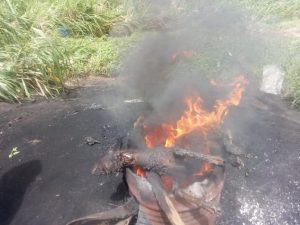
Slaughterhouses: One of the Highest Pollutants in Nigeria
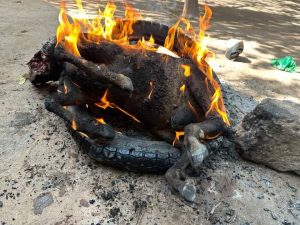
In Nigeria, thousands of used car tyres are burned daily in abattoirs to roast animals, making slaughterhouses one of the leading contributors to environmental pollution across the country—and indeed, Africa.
A slaughterhouse, or abattoir, is not just a facility for processing animals for food; in Nigeria, it also serves as a bustling marketplace where people gather to exchange goods and services. In many of these centers, particularly in urban areas, over 1,000 people visit daily to buy or sell meat, food items, or other goods.
Slaughterhouses are common in virtually every local government area in Nigeria. However, a troubling practice in these facilities involves using firewood or—more frequently—used tyres as fuel to process animal carcasses. Due to the rising cost of firewood, many butchers have turned to burning discarded car tyres to roast animal hides and skins, especially for preparing local delicacies like ponmo (cowhide).
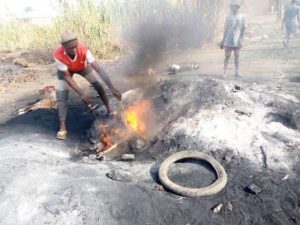
Environmental and Health Hazards
This practice poses serious risks to human health and the environment. Thick black smoke from burning tyres is a common sight near slaughterhouses, especially in Northern Nigeria, where climate change and desert encroachment are already having severe impacts.
In Kaduna State alone, there are over 10 slaughterhouses in the metropolitan area and many more spread across the 23 local government areas. A single slaughterhouse in Kakuri, Kaduna South, reportedly processes about 10 cows, 200 goats, and numerous chickens daily—using an average of 14 tyres per day. Larger facilities in areas like Tudun Wada, Sabo Tasha, and Kawo are estimated to use even more.
Mallam Usman, a butcher at the Kakuri slaughterhouse, confirmed that roasted hides, popularly known as Kpomo, are prepared using burning tyres. This method, though cost-effective, is dangerous. Environmentalist Comrade Jibrin Ibrahim criticized this trend and called for regulatory action to curb the practice.
The Science Behind the Danger
Used tyres contain hazardous materials not meant to be released through burning. They are composed of chemicals such as:
Extender oils from Benzene
Styrene, a Benzene derivative
1,3-Butadiene, a known carcinogen
Dr. Yusuf Nadabo, Patron of African Climate Reporters and former Head of Anatomy at Kaduna State University, emphasized the health risks. He explained that fine particulates from tyre smoke are extremely dangerous because they penetrate deep into the lungs. Vulnerable groups such as pregnant women, children, the elderly, and immunocompromised individuals face higher health risks from these toxins.
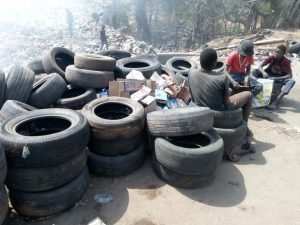
He added that burning tyres increases emissions of dioxins and mercury—substances known for their toxicity and carcinogenic properties. Dioxins, in particular, are among the most harmful chemicals to humans and can accumulate in the food chain.
Dr. Nadabo stated, “If just five tyres are used daily in each of Nigeria’s 774 local government areas, the cumulative emissions are staggering. Should we wait until irreversible harm is done before taking action?”
Wider Environmental Impact
Beyond air pollution, burning tyres also pollutes water and soil. According to the U.S. Environmental Protection Agency (EPA), burning one million tyres produces about 55,000 gallons of runoff oil. If not contained, this oil can contaminate rivers, lakes, and underground water sources. Moreover, the leftover residue from burning tyres introduces toxic materials into the soil, impacting agriculture and ecosystems.
Human Health Risks
Dr. Tijjani Salisu, a veterinary doctor and environmental consultant, warned against consuming ponmo prepared with burning tyres. He said the practice raises the concentration of heavy metals like lead and cadmium in the animal hide—posing serious health risks when consumed.
He emphasized that while boiling slightly reduces these toxins, it does not bring them below safe consumption levels. Toxic fumes like carbon monoxide also affect abattoir workers and nearby residents.
“Many butchers have never undergone health checks,” Dr. Salisu said. “When some die unexpectedly, no one investigates the cause, and the practice continues.”

He called for immediate intervention from regulatory agencies to enforce proper slaughtering methods and discourage the use of tyres.
Government and Policy Recommendations
While the Nigerian government has made efforts to regulate slaughterhouse practices, much more needs to be done. Experts recommend the following:
Enforce strict regulations on the disposal and reuse of scrap tyres.
Ban the use of tyres as fuel in slaughterhouses.
Encourage modern, sustainable animal processing techniques.
Educate butchers on health and environmental risks.
Construct waste treatment and recycling facilities.
Animal waste from abattoirs is also a significant contributor to greenhouse gas emissions—yet often overlooked. Improper disposal methods introduce drug-resistant pathogens and methane into the environment, compounding public health and climate concerns.
A Global Concern
According to Dr. David Matyew, a tyre industry researcher, tyres are made with numerous harmful components, including microplastics, heavy metals, and volatile chemicals. These materials are increasingly recognized as contributors to global air and water pollution, with potential impacts on human and animal health.
Addressing the environmental and public health crisis caused by the use of used tyres in Nigerian slaughterhouses requires a multifaceted, practical, and enforceable approach. Here’s a breakdown of short-, medium-, and long-term solutions that involve the government, private sector, civil society, and local communities:

Proposed Solutions to Tyre Burning in Slaughterhouses
🔹 1. Ban the Use of Tyres as Fuel in Abattoirs
Policy Action: The federal and state governments should pass and enforce laws that explicitly prohibit the burning of used tyres for roasting animals.
Enforcement: Task environmental protection agencies (NESREA, state EPAs, and public health departments) with routine inspections and enforcement.
Penalties: Introduce fines or business closures for slaughterhouses that violate the law.
🔹 2. Provide Affordable and Cleaner Alternatives
Subsidize Clean Energy: Government can subsidize biogas, LPG (cooking gas), or energy-efficient roasting stoves for butchers.
Pilot Cleaner Technology: Introduce solar-powered animal skin dryers or roasters as a pilot program in major cities like Kaduna, Kano, and Lagos.
Promote Waste-to-Energy Programs: Organic waste from abattoirs (like fat, blood, and manure) can be converted into biogas for internal use.
🔹 3. Regulate and Recycle Scrap Tyres
National Tyre Collection Policy: Require tyre sellers and vulcanizers to register scrap tyres and deliver them to approved recycling centers.
Incentivize Tyre Recycling: Offer tax breaks or grants to companies that convert scrap tyres into construction material (e.g., rubber bricks, asphalt, playground flooring).
🔹 4. Educate and Train Butchers
Public Health Campaigns: Raise awareness about the health risks of using tyres to process meat—especially ponmo—through radio, TV, and local language campaigns.
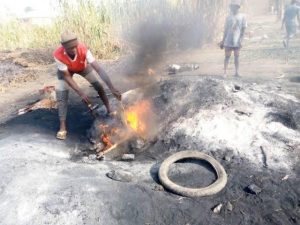
Capacity Building: Organize workshops for butchers and abattoir workers on safe and modern animal processing methods.
Community Engagement: Work with local chiefs, market leaders, and religious organizations to discourage the tyre-burning practice.
🔹 5. Improve Infrastructure and Sanitation in Abattoirs
Upgrade Slaughterhouses: Build or rehabilitate abattoirs with designated roasting areas, proper ventilation, and access to clean water and energy.
Waste Management Systems: Establish drainage, filtration, and waste recycling facilities to minimize environmental contamination.
Health Monitoring Units: Deploy regular health screenings for workers and mandatory hygiene training.
🔹 6. Strengthen Monitoring and Enforcement
Create Task Forces: Set up local and state abattoir task forces under Ministries of Environment and Health to carry out surprise checks.
Digital Reporting Tools: Introduce anonymous platforms (via mobile apps or SMS) where citizens can report illegal tyre burning in slaughterhouses.
🔹 7. Engage Private Sector and NGOs
Public-Private Partnerships (PPP): Encourage private investment in sustainable abattoir infrastructure and clean energy tech.
NGO Support: Partner with health and environmental NGOs for public education, monitoring, and advocacy.
🔹 8. Research and Data Collection
Fund Independent Studies: Encourage universities and research institutes to study the health and environmental effects of current abattoir practices.
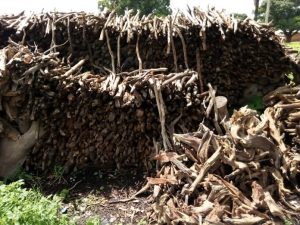
Data-Driven Policy: Use evidence to develop localized and evidence-based policies.
🌍 Broader Benefits of These Solutions
✅ Reduces toxic emissions and improves public health
✅ Protects soil, water, and air from long-term contamination
✅ Encourages green jobs and sustainable development
✅ Enhances food safety and global export potential for Nigerian meat
✅ Helps Nigeria meet its climate commitments (SDGs and Paris Agreement)

Conclusion
The importance of abattoirs in providing protein to Nigeria’s population cannot be overstated. However, current practices—especially the use of tyres to roast animal hides—pose a severe threat to public and environmental health. This calls for urgent government action, public education, and the development of sustainable alternatives to safeguard both human lives and the planet.




















